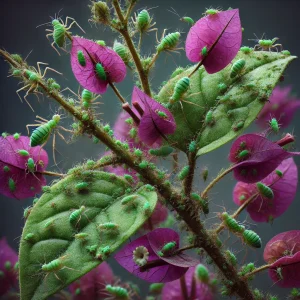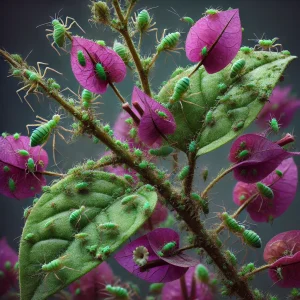Bougainvilleas are renowned for their stunning, vibrant flowers and vigorous growth, making them a favorite among gardeners.
However, like all plants, Bougainvilleas they are not immune to a range of pests and diseases that can significantly impact their health and beauty. Identifying these threats early is crucial to ensuring your bougainvillea thrives year-round.
With the right tools and knowledge needed to prevent, manage, and treat Bougainvilleas pests and diseases effectively you can enjoy a beautiful, flourishing bougainvillea for years to come.
In this article, we will delve into the most common pests and diseases that affect bougainvilleas, offering detailed information and clear images to help you recognize potential problems.
Related: Best Insecticide For Bougainvillea
10 Best Bougainvillea Pests And Diseases Pictures
Whether it’s insect infestations or fungal infections, understanding how to spot these issues and how to treat them is key to maintaining the health and vibrancy of your bougainvillea.
1. Aphids on Bougainvillea (Aphis spp.)
Aphids are tiny, pear-shaped insects that are typically green, black, or yellow. They tend to gather in clusters on the undersides of leaves and new shoots, feeding on plant sap. Their feeding weakens the plant and causes the leaves to curl, turn yellow, or even fall off.

In addition to the visible damage, aphids also secrete a sticky substance known as honeydew. This honeydew attracts ants and encourages the growth of sooty mold, which can further harm the plant. The presence of honeydew can also cause a shiny, sticky residue on nearby surfaces.
To control aphids, start by spraying the affected bougainvillea with a mixture of water and mild soap. This will help dislodge the aphids without harming the plant. You can also use insecticidal soap or neem oil for a more effective treatment that prevents future infestations.
Picture: [Image showing aphids clustered on bougainvillea leaves]
2. Bougainvillea Caterpillar (Spodoptera spp.)
Bougainvillea caterpillars are the larvae of moths that feed on the plant’s leaves, flowers, and stems. These caterpillars can grow to a significant size and may cause considerable damage, leaving behind holes in the foliage and chewed flower buds. They often appear as green or brown worms, and you can find them near affected areas.
As they feed, caterpillars can quickly strip the plant of its leaves, hindering photosynthesis and weakening the plant’s overall health. Their feeding activity can also lead to the early drop of flower buds. If the infestation is severe, it can result in the plant becoming bare and unhealthy.
To control bougainvillea caterpillars, you can manually remove them from the plant by handpicking. For larger infestations, apply Bacillus thuringiensis (Bt), a biological insecticide that targets caterpillars without harming other beneficial insects. Regularly inspecting your plant and removing caterpillars early can prevent widespread damage.
Picture: [Image showing a bougainvillea caterpillar feeding on a leaf]
3. Bougainvillea Whitefly (Bemisia tabaci)
Bougainvillea whiteflies are tiny, white flying insects that often infest the undersides of leaves. These pests feed on the plant’s sap, causing the leaves to yellow and weaken over time. The whiteflies secrete honeydew, which leads to the growth of sooty mold on the plant’s surface.
The presence of whiteflies can also cause a reduction in the plant’s vigor and flowering. As the plant struggles with sap loss, it may become more susceptible to other stressors such as drought or disease. Whiteflies are particularly difficult to control because they multiply rapidly and can quickly spread to nearby plants.
To control whiteflies, use yellow sticky traps to capture the adults, as they are attracted to the color yellow. Additionally, apply insecticidal soap or neem oil to the plant, which will kill the pests without harming the bougainvillea. Regular monitoring and early intervention can help prevent a large infestation.
Picture: [Image showing a cluster of whiteflies on bougainvillea leaves]
4. Bougainvillea Rust (Puccinia bougainvilleae)
Bougainvillea rust is a fungal disease that affects the plant’s leaves, causing them to develop orange or yellow pustules. These pustules contain spores that spread the infection to other parts of the plant and nearby bougainvilleas. Rust can lead to premature leaf drop and significantly reduce the plant’s overall health.
The disease thrives in humid environments, where the spores can easily spread from leaf to leaf. As the infection progresses, the leaves begin to curl and distort, and the plant’s growth becomes stunted. Infected bougainvilleas may also exhibit a decrease in flower production due to the plant’s weakened state.
To control bougainvillea rust, remove and dispose of any infected leaves to reduce the spread of the disease. Fungicides, such as copper-based products, can be applied to the plant to eliminate the fungal spores. Ensuring proper airflow around the plant and avoiding overhead watering can also help reduce the likelihood of rust development.
Picture: [Image showing bougainvillea leaves with rust infection]
5. Bougainvillea Leaf Spot (Cercospora spp.)
Bougainvillea leaf spot is a fungal infection that causes dark, circular spots to appear on the leaves. These spots are often surrounded by a yellowish halo, making them easy to identify. As the infection progresses, the spots may enlarge, leading to the premature drop of affected leaves.
The disease thrives in damp conditions and spreads quickly if not managed. Infected leaves weaken the plant and can lead to stunted growth or reduced flowering. If left unchecked, leaf spot can cause significant aesthetic damage to your bougainvillea.
To treat bougainvillea leaf spot, remove and discard infected leaves to prevent further spread. Apply fungicides labeled for leaf spot diseases, such as sulfur-based or copper fungicides, to kill the fungal spores. Regularly inspecting your plant and maintaining proper spacing between plants can reduce the risk of leaf spot.
Picture: [Image showing bougainvillea leaf spot symptoms]
6. Mealybugs (Pseudococcus spp.)
Mealybugs are soft-bodied insects covered in a white, waxy coating. These pests are notorious for feeding on the stems, leaves, and roots of bougainvilleas, causing wilting, yellowing, and stunted growth. They secrete honeydew, which leads to the growth of sooty mold and attracts ants.
As mealybugs feed, they weaken the plant by draining its sap and disrupting the flow of nutrients. Severe infestations can cause the plant to become deformed or even die. Additionally, mealybugs can spread diseases from plant to plant, making early detection essential.
To control mealybugs, spray the plant with insecticidal soap or neem oil to kill the insects without harming the bougainvillea. You can also use alcohol wipes to manually remove visible mealybugs. Regular monitoring and removing affected parts early can help keep mealybug populations under control.
Picture: [Image showing mealybugs on bougainvillea stems]
7. Bougainvillea Mildew (Oidium spp.)
Powdery mildew is a fungal disease that affects bougainvillea by producing a white, powdery coating on leaves and flowers. This fungal infection reduces the plant’s ability to photosynthesize, leading to stunted growth and reduced vigor. It can also cause distorted or deformed leaves and flowers, making the plant less aesthetically pleasing.
The disease thrives in warm, dry conditions with poor air circulation. Powdery mildew is often seen during hot summers, especially in crowded or shaded areas. If not treated, it can significantly hinder the plant’s growth and flowering.
To manage powdery mildew, improve air circulation around the bougainvillea by pruning any dense foliage. Apply fungicides designed for powdery mildew control, such as sulfur or potassium bicarbonate. Regularly inspect the plant for early signs of infection to prevent it from spreading.
Picture: [Image showing bougainvillea with powdery mildew]
8. Root Rot (Phytophthora spp.)
Root rot is a fungal disease caused by the pathogen Phytophthora, which thrives in waterlogged soil. The disease leads to the rotting of bougainvillea roots, causing the plant to wilt, yellow, and die. Infected plants often display signs of stress, such as drooping leaves, even when watered properly.
This disease is commonly caused by poor drainage, which leads to excess moisture around the roots. The fungus attacks the root system, cutting off the plant’s ability to absorb water and nutrients. As a result, the bougainvillea becomes weak and more susceptible to other stressors, such as pests and environmental changes.
To prevent and manage root rot, ensure that your bougainvillea is planted in well-draining soil. Water the plant only when the soil is dry to avoid overwatering, which can exacerbate the problem. If the plant is already infected, remove the affected roots and apply a fungicide to prevent further spread.
Picture: [Image showing bougainvillea roots with signs of rot]
9. Bougainvillea Thrips (Frankliniella spp.)
Thrips are tiny, slender insects that feed on bougainvillea flowers, leaves, and stems. These pests cause damage by piercing the plant tissue and sucking out the sap, leading to deformed or silvered leaves. They are often difficult to spot due to their small size but can cause significant damage over time.
Thrips are particularly harmful to bougainvillea flowers, which can become discolored or malformed due to their feeding. The damage results in poor plant appearance and reduced flowering. In severe cases, the infestation may cause the plant to become stunted and weak.
To control thrips, use yellow sticky traps to capture the adults, as they are attracted to the color yellow. You can also spray the bougainvillea with insecticidal soap or neem oil to eliminate the pests. Regularly inspect your plant for signs of thrips and act quickly to prevent an infestation.
Picture: [Image showing thrips damage on bougainvillea flowers]
10. Bougainvillea Scale (Aonidiella spp.)
Scale insects are small, immobile pests that attach themselves to the stems, leaves, and branches of bougainvilleas. They appear as hard, brown or white bumps that feed on the plant’s sap, weakening it over time. Scale insects often go unnoticed until significant damage is done, making early detection crucial.
As scale insects feed on the plant’s sap, they cause the leaves to yellow and the plant to become stunted. The presence of honeydew and black mold further complicates the issue. Severe infestations can even cause branches to die back, leading to further decline.
To manage scale insects, manually scrape them off the plant or use a cotton swab dipped in rubbing alcohol to remove them. Apply horticultural oil or insecticidal soap to eliminate any remaining pests. Regularly inspect your bougainvillea for signs of scale and remove any affected areas promptly.
Picture: [Image showing bougainvillea scale on a stem]
Bougainvillea Pests And Diseases FAQs
- What are the most common pests on bougainvillea?
- Aphids, whiteflies, caterpillars, and mealybugs are the most common pests that affect bougainvilleas.
- How can I prevent pests on my bougainvillea?
- Regularly inspect your plants, use insecticidal soap, and encourage beneficial insects like ladybugs.
- How do I treat bougainvillea for rust?
- Remove infected leaves and apply fungicides designed for rust control.
- What is the best way to control bougainvillea scale?
- Manually scrape off the scales and use insecticidal soap or horticultural oil.
- Is powdery mildew harmful to bougainvillea?
- Yes, powdery mildew can stunt growth and reduce flowering, but it can be controlled with fungicides.
- Can I save a bougainvillea with root rot?
- If caught early, root rot can be mitigated by improving drainage and cutting away the affected roots.
- Why are my bougainvillea leaves turning yellow?
- Yellowing leaves can be a sign of pests, diseases, or nutrient deficiencies.
Conclusion
Bougainvilleas are beautiful, resilient plants that can brighten up any garden, but they are susceptible to various pests and diseases.
By learning to identify common issues like aphids, rust, and powdery mildew, you can take swift action to protect your Bougainvilleas plant. Regular inspection, proper care, and timely intervention are key to keeping your bougainvillea healthy and vibrant.
Remember, a healthy bougainvillea not only adds color to your landscape but also thrives with minimal stress. Take action today to ensure your bougainvillea stays pest-free and disease-resistant. Happy gardening!
Recent Posts
best insecticide for hibiscus
Hibiscus plants, renowned for their vibrant blooms and tropical charm, thrive when nourished with the right fertilizers. Whether you're cultivating hardy, tropical, or hybrid varieties, selecting...